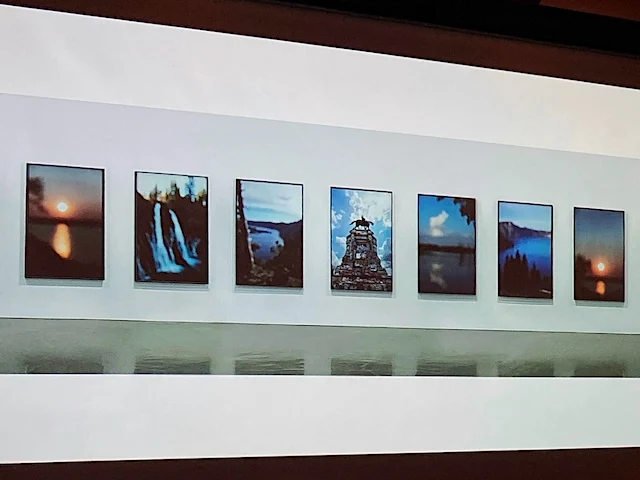Cathy Opie's Landscapes
I was surprised to see landscape represented in Cathy Opie’s recent work. I often find myself frustrated by artists who’ve taken on landscape later in their career, but if I am honest, this feeling is sometimes nothing more than professional jealousy. Given that, how easy it would be to couch that jeolousy in a negative critique of the work. It seems I can forget that landscape doesn’t belong to me, or anyone, but for a few hundred years, has been a symbolic entity that artists can tap, turn over, reproduce or renounce.
 |
| The swamp landscape of Opie's Rhetorical Landscapes |
Although Opie says shots are unplanned, or there is little preparation, or it’s all in her head, what materializes is always passed through her razor sharp filter. In her exhibit, Rhetorical Landscapes (2020), she presented photographs of the Okefenokee Swamp adjacent to floor-standing screens displaying animated magazine clippings. Opie frames these swamp photographs in terms of the Trump administration’s undermining of climate goals, rising seas, and its effect on these southeastern U.S. swamps, but there is more to it than that.
Trump’s rhetoric makes great use of the swamp image, commonly understood as a murky waste, dark, mysterious, where dangerous creatures lurk just beneath the surface. In doing so, he leverages the symbolic power of landscape to transport and amplify fear across heterogenious social, geographic and cultural terrain. Taking a cue from the juvenile “Who ever smelt it, dealt it,” in pointing to the swamp, Trump reveals he is the very swamp he’s invoked. That Opie pictures the Okefenokee, as opposed to other, if not equally vast, swamps appears logical given the American electorate’s association, however faulty, of the nation’s malignant inclinations with historically rebellious southern states. In these two ways, Opie’s swamp landscapes function as other landscape images have before —representative, or in service, of a nation’s identity.
This meaning is turned on its head when the swamp continues to be seen as mysterious, misunderstood, and threatening but is also threatened. A landscape that holds this (threatening/threatened) and other dualities (land/sea) suggests the swamp’s metaphorical potential to be representative of queer identity. This interpretation is supported by Rhetorical Landscape’s exhibition design in which the swamp photos are hung on the outer wall, apart from central, free-standing kiosks of animated collage that are representative, and a critique, of American culture at large. I prefer this take over the more academic approach. It’s more intriguing and a refreshing break from the critique of landscape as long-ago exhausted and forever beholden to the capitalist-imperialist enterprise.
 |
| One of Opie's blurred landscapes -only a portion of a larger work. |
 |
| The full work: blurred landscapes bookend a monument to the rebel cause. |
 |
| One of Opie's Norway mountain landscapes. Image reproduces color and tonality poorly. |
More recently, Opie has been photographing mountains in Norway. She intimated this flirt with beauty was tinged with guilt. Beauty, like landscape, is overloaded. Rather than beauty, could this work be about the pleasure inherent to the experience of calming, blue tonalities. Isn’t there room for calm —especially after 4 (just 4?) years of Trump? Whenever we speak of guilty pleasures, there is always a sense that judgement is entirely unfair.
Although described as a critique of the Catholic Church, I found Opie's most recent work “Walls, Windows and Blood” her most abstract and engagingly ambiguous. Most impactful are the "Blood Grids." Not only do they compellingly capture the textures, colors, and light inherent to painting, but by fracturing the original whole, the photographs create incredibly intimate moments with the physical work unlikely to be had in a crowded museum. I can only imagine the pleasure she had in arranging these pieces. Her process reclaims the artistry of, and becomes a spiritual union with, those original artists who had little choice but to serve the power of the Church.
Although described as a critique of the Catholic Church, I found Opie's most recent work “Walls, Windows and Blood” her most abstract and engagingly ambiguous. Most impactful are the "Blood Grids." Not only do they compellingly capture the textures, colors, and light inherent to painting, but by fracturing the original whole, the photographs create incredibly intimate moments with the physical work unlikely to be had in a crowded museum. I can only imagine the pleasure she had in arranging these pieces. Her process reclaims the artistry of, and becomes a spiritual union with, those original artists who had little choice but to serve the power of the Church.

Simultaneously, the modernist grid Opie uses to structure the assemblage of photographs ties the violence of the Catholic Church exacted across the globe to the universalist, global enterprise of aesthetic Modernism. In a manner homologous to the power of the Church, Modernism has had an unassailable authority over artists and, although not bloody, for some generations, has been an oppressively misanthropic and homogenizing force. Although the grid speaks to the rigidity of Church doctrine, the Church's fetish for flesh and blood undermines the excess of Modernist rationality. Opie's subversive gesture is the simultaneous binding and contrasting of these forces, not quite canceling each out, but rather holding them in a revealing, dynamic tension.
Comments
Post a Comment
Go ahead and comment! I will moderate and delete the spam. Thx